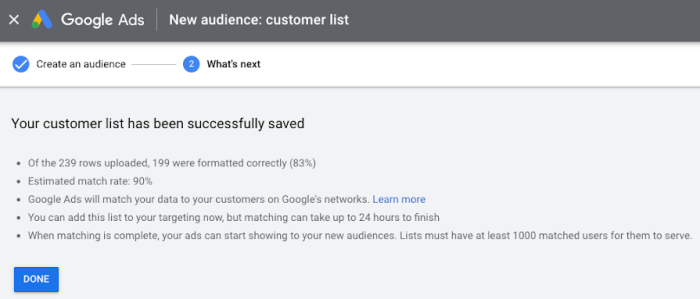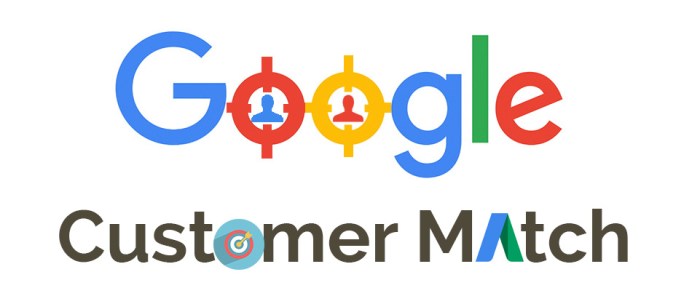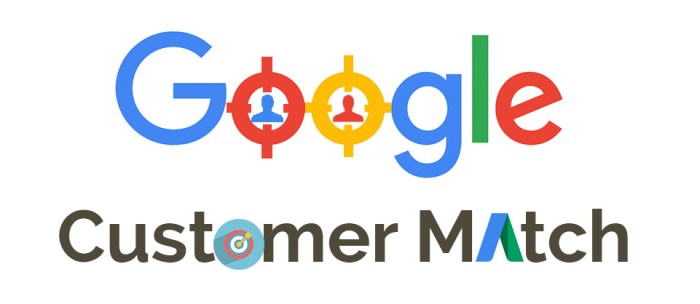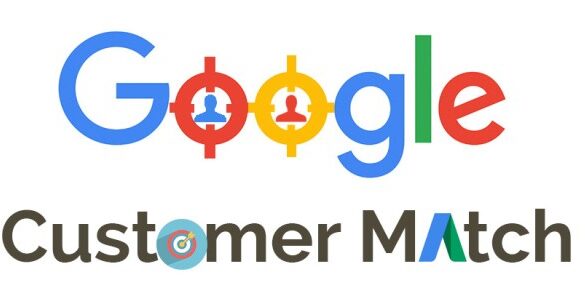Google AdWords Customer Match allows you to target your ads to specific customers based on their information. This powerful tool leverages data like email addresses, phone numbers, and customer IDs to create highly-targeted campaigns, significantly improving the chances of conversions. Understanding the intricacies of data collection, integration, and targeting strategies is crucial to maximize the effectiveness of Customer Match campaigns.
This guide delves into the various aspects of Google AdWords Customer Match, from fundamental concepts to advanced strategies, providing actionable insights to boost your marketing efforts. We’ll cover data collection methods, targeting techniques, campaign optimization, and crucial measurement strategies.
Introduction to Google AdWords Customer Match
Google AdWords Customer Match is a powerful tool that allows advertisers to connect with their existing customer base on Google’s advertising platform. It leverages user data to create targeted ad campaigns that are more likely to resonate with and convert prospects who have previously interacted with the company. This targeted approach enhances campaign efficiency and significantly improves return on investment.Customer Match empowers advertisers to reach their most valuable customers—those who have already expressed interest in their products or services—with personalized messaging.
By tailoring ads to specific user profiles, businesses can improve engagement and ultimately drive higher conversion rates. It offers a significant advantage in the highly competitive digital advertising landscape.
Fundamental Purpose and Benefits
Customer Match’s primary purpose is to enable businesses to connect with their existing customer database within the Google Ads ecosystem. This facilitates personalized advertising campaigns that are tailored to individual user interests and past behaviors. Crucially, this results in increased ad relevance and higher conversion rates. By delivering more targeted ads, businesses can optimize their ad spend and achieve a better return on investment.
Key Features and Functionalities
Customer Match offers several key functionalities that enhance targeted advertising. These include the ability to upload customer data such as email addresses, phone numbers, or customer IDs. Google then uses this data to identify users within its platform and deliver personalized ads to them. This personalized approach significantly increases the effectiveness of advertising campaigns, driving higher engagement and conversions.
Examples of Use Cases
Customer Match can be effectively utilized across various marketing campaigns. For instance, businesses can re-engage customers who abandoned their shopping carts on the website. Personalized email campaigns, coupled with targeted ads, can remind customers of the items they left behind and encourage completion of the purchase. Additionally, Customer Match can be used to reach customers who have expressed interest in a specific product or service, ensuring that ads are relevant and engaging.
Data Types for Customer Match
| Data Type | Description | Example | Use Case |
|---|---|---|---|
| Email Addresses | Unique identifiers associated with individual user accounts. | [email protected] | Re-engaging customers who previously visited the website or subscribed to the newsletter. |
| Phone Numbers | Unique identifiers for individual users. | +1-555-123-4567 | Promoting special offers or sending exclusive discounts to existing customers. |
| Customer IDs | Internal identifiers uniquely assigned to customers by the business. | CUST12345 | Targeting customers who have made previous purchases or interacted with customer support. |
| Website Cookies | Data points that track user interactions with a website. | Unique identifier assigned to a user’s browser. | Retargeting users who have visited specific product pages or shown interest in a particular product line. |
Data Collection and Integration

Customer Match empowers advertisers to reach highly targeted audiences by leveraging existing customer data. A crucial aspect of this process lies in effectively collecting and integrating this data into the Google AdWords platform. This section delves into the various methods used for data collection, the procedures for seamless integration, and the importance of data preparation for optimal results.
Data Collection Methods
Collecting accurate and relevant data is paramount for a successful Customer Match campaign. Different methods offer varying degrees of accessibility and suitability depending on the advertiser’s existing infrastructure and marketing strategies. The table below contrasts various data collection approaches, highlighting their advantages and disadvantages.
Google AdWords Customer Match is a powerful tool, but maximizing its impact requires a strong online presence. To truly reach your target audience, you need a robust link building strategy, and that’s where 13 efficient link building strategies for busy marketers come in handy. Understanding how to build high-quality backlinks will significantly improve your ad campaigns’ effectiveness, ultimately boosting conversions for your Google AdWords Customer Match campaigns.
| Method | Pros | Cons | Applicability |
|---|---|---|---|
| Website Forms | Allows for direct collection of user information; easy to tailor to specific customer segments; facilitates building detailed customer profiles. | Requires user interaction and consent; can be cumbersome to manage if forms are complex; might not capture all desired data points. | Ideal for businesses collecting information about website visitors or lead generation. |
| App-Based Data | Offers a rich source of behavioral data; tracks user engagement and app usage patterns; allows for precise targeting. | Requires app integration with Google’s systems; data privacy concerns might be amplified; may require user opt-in for data sharing. | Suitable for businesses with mobile applications, enabling targeting based on in-app behavior. |
| CRM Integrations | Provides access to a wealth of pre-existing customer data; streamlines data transfer; allows for a unified view of customer interactions. | Requires compatibility with Google’s systems; integration can be complex and time-consuming; potential data security concerns must be addressed. | Excellent for companies using Customer Relationship Management (CRM) software to manage customer interactions. |
| Mailing Lists | Can be a cost-effective method for data collection, especially for existing customer bases; provides access to email addresses. | Data quality can vary; may not capture comprehensive user information; requires careful management to comply with data privacy regulations. | Useful for businesses that have established email lists, enabling targeting based on email addresses. |
Data Integration Procedures
Once data is collected, the integration process with Google Customer Match is crucial. Advertisers need to ensure that the data is properly formatted and prepared for accurate matching.The integration process generally involves uploading the data to Google’s platform, ensuring compliance with data privacy regulations, and confirming that the data meets the required format specifications. Google provides detailed instructions and support to facilitate this process.
Data Formats
Google Customer Match supports various data formats for seamless integration. The platform accommodates different structures, ensuring compatibility with diverse data sources. This flexibility allows businesses to leverage data from various systems and platforms. A crucial aspect of the process involves data validation and cleansing.
Data Cleansing and Preparation
Data cleansing and preparation are critical steps for achieving accurate and effective Customer Match campaigns. This stage ensures that the data uploaded is accurate, consistent, and complete. It involves identifying and correcting errors, ensuring data integrity, and formatting the data to match the required specifications.Data validation checks for inaccuracies and inconsistencies. This process involves checking for missing values, duplicate entries, and incorrect data types.
Data standardization ensures uniformity across the dataset. This includes standardizing email addresses, phone numbers, and other data points.
Targeting Strategies and Campaign Optimization
Customer Match empowers advertisers to move beyond broad demographics and interests, enabling precise targeting based on actual customer interactions. This detailed approach allows for highly relevant advertising, resulting in increased engagement and conversions. Understanding the nuances of targeting strategies and campaign optimization with Customer Match is crucial for maximizing return on investment (ROI).
Various Targeting Strategies Enabled by Customer Match, Google adwords customer match
Customer Match allows for several targeted strategies that leverage the collected customer data. These strategies include retargeting previous website visitors, engaging with customers who have engaged with specific products or services, and targeting customers who have shown interest in particular promotions or offers. By understanding the specific actions and preferences of your customers, you can tailor your campaigns for optimal effectiveness.
Optimizing Campaigns Using Customer Match Data
Campaign optimization with Customer Match data involves a dynamic process of analyzing campaign performance and adjusting targeting parameters accordingly. Key performance indicators (KPIs) such as click-through rates (CTR), conversion rates, and cost per acquisition (CPA) are crucial for monitoring campaign effectiveness. Adjustments to targeting criteria, ad copy, and bidding strategies can be made based on the observed trends.
This iterative process allows advertisers to refine their campaigns and achieve better results over time.
Segmenting Customer Data for Targeted Advertising
Segmenting customer data for targeted advertising is a crucial aspect of optimizing Customer Match campaigns. By grouping customers based on shared characteristics, behaviors, or preferences, you can tailor messaging and offers to specific segments, improving relevance and response rates. This could include segmenting customers by purchase history, website activity, or engagement with specific marketing materials. Segmenting your customer data is a powerful technique that leads to higher conversion rates.
Comparing Customer Match Targeting with Other Strategies
Customer Match offers a unique advantage over other targeting strategies. While demographic targeting relies on broad generalizations, and interest-based targeting can be less accurate, Customer Match uses verified customer data for highly personalized and relevant advertising. This approach often results in higher conversion rates and lower costs per acquisition.
Tailoring Ad Copy and Messaging for Customer Match Audiences
Tailoring ad copy and messaging for Customer Match audiences is vital for driving engagement. Advertisers should tailor their messaging to address the specific needs and interests of their targeted customer segments. This might include highlighting the specific products or services that a customer segment has shown interest in, or showcasing promotions that align with their prior purchases or behaviors.
By addressing the needs of the specific audience, the ad campaign will be much more effective.
Comparison Table: Customer Match vs. Other Targeting Methods
| Feature | Customer Match | Demographics | Interests |
|---|---|---|---|
| Accuracy | High, based on verified customer data | Low, broad generalizations | Moderate, relies on inferred interests |
| Cost | Potentially lower CPA, higher ROI | Variable, can be high if targeting is broad | Variable, depends on the accuracy of interest data |
| Reach | Targeted, can be more focused than demographics | Broad, potentially reaching irrelevant audiences | Potentially broad, may not reach all relevant customers |
| Relevance | High, highly personalized messaging | Low, may not align with individual customer needs | Moderate, may not perfectly match all customer interests |
Measurement and Reporting

Tracking the performance of your Google AdWords Customer Match campaigns is crucial for optimizing your strategies and maximizing return on investment. Understanding how to measure effectiveness and interpret reports allows you to fine-tune your campaigns for better results. Regular monitoring and analysis are essential to identify trends, pinpoint areas for improvement, and ultimately drive more conversions.
Key Performance Indicators for Customer Match
Customer Match campaign success hinges on careful monitoring of key performance indicators (KPIs). These metrics provide a clear picture of campaign effectiveness and highlight areas needing attention. Tracking these KPIs is critical for achieving campaign goals.
Google AdWords Customer Match is a powerful tool for targeting your ideal customers. It helps you connect with people who’ve already shown interest in your brand, leading to higher conversion rates and improved return on ad spend. This directly impacts lead generation and brand awareness, as seen in our detailed guide on lead generation and brand awareness.
Ultimately, Customer Match helps you fine-tune your ad campaigns for optimal results.
- Click-Through Rate (CTR): The CTR measures the percentage of people who see your ad and click on it. A high CTR suggests your ad copy and targeting are effective in attracting your desired audience. A low CTR might indicate that your ad messaging isn’t resonating with your target customers or that your targeting is too broad.
- Conversion Rate: This metric measures the percentage of clicks that result in a desired action, such as a purchase or a form submission. A higher conversion rate signifies that your campaign is effectively driving desired actions. A lower conversion rate might suggest problems with your landing page, ad copy, or overall user experience.
- Cost-Per-Acquisition (CPA): CPA reflects the cost incurred to acquire a single customer. A lower CPA signifies a more cost-effective campaign, allowing for more efficient allocation of advertising budgets. A high CPA might indicate issues with your targeting or ad copy, potentially needing adjustments.
- Return on Ad Spend (ROAS): ROAS calculates the revenue generated for every dollar spent on advertising. A high ROAS demonstrates a profitable campaign. A low ROAS suggests that the cost of acquiring customers outweighs the revenue generated. A detailed analysis of ROAS can reveal which aspects of the campaign are performing well and which need improvement.
Analyzing Customer Match Reporting Data
Analyzing the reporting data from your Customer Match campaigns is essential to understand the performance and identify opportunities for improvement. Regular review of reports allows you to identify trends, pinpoint issues, and optimize your campaigns for better results. By interpreting the data accurately, you can fine-tune your targeting, ad copy, and bidding strategies to maximize campaign effectiveness.
Google AdWords Customer Match is a powerful tool, but sometimes your ads need a little extra oomph. Think about co-branding with research – like in this article about co branding with research making your b2b content stand out. By leveraging external expertise, you can create compelling content that resonates with your target audience, making your ads more effective.
This can significantly boost your Customer Match campaigns.
| Metric | Description | Interpretation | Actionable Insights |
|---|---|---|---|
| Click-Through Rate | Percentage of impressions resulting in clicks. | High CTR indicates effective ad copy and targeting. Low CTR suggests a need for improvements in ad messaging or targeting. | Refine ad copy, adjust targeting parameters, A/B test different ad variations. |
| Conversion Rate | Percentage of clicks that lead to desired actions. | High conversion rate signifies effective campaign structure and user experience. Low conversion rate indicates issues with landing pages or ad copy, potentially needing optimization. | Improve landing page design, optimize ad copy, enhance user experience. |
| Cost-Per-Acquisition | Cost incurred to acquire a single customer. | Lower CPA indicates cost-effective customer acquisition. High CPA suggests potential inefficiencies in targeting or ad copy, requiring adjustments. | Refine targeting, optimize ad copy, test different bidding strategies. |
| Return on Ad Spend | Revenue generated for every dollar spent on advertising. | High ROAS signifies a profitable campaign. Low ROAS suggests that the cost of customer acquisition is exceeding revenue generated, requiring optimization. | Adjust bidding strategies, improve targeting, optimize ad copy, and assess landing page effectiveness. |
Best Practices and Considerations
Customer Match in Google AdWords offers a powerful way to connect with your ideal customers. However, successful implementation requires careful planning, data management, and ongoing optimization. This section explores best practices, potential pitfalls, and strategies for mitigating risks to ensure your campaigns are effective and ethical.Implementing Customer Match effectively involves more than just uploading a customer list. It requires a strategic approach focused on data accuracy, privacy, and campaign performance.
By understanding the potential challenges and adopting best practices, you can maximize the return on investment while safeguarding customer trust.
Best Practices for Implementing Customer Match
Effective Customer Match implementation relies on a meticulous approach. Start by ensuring data accuracy and completeness. Verify the quality of your customer data, checking for errors, inconsistencies, and missing information. This step is crucial for preventing inaccurate targeting and wasted ad spend. Implement robust data validation processes to ensure accuracy before uploading your customer list.
Additionally, segment your customer data to create targeted ad groups, enabling more personalized messaging and improved conversion rates. Consider using hashed email addresses to protect user privacy while maintaining campaign effectiveness. Finally, track and analyze campaign performance, using the data to refine your targeting strategies and optimize your ad copy.
Considerations When Using Customer Match
Several critical considerations need attention when utilizing Customer Match. Understanding data privacy regulations, like GDPR, is paramount. Adherence to these regulations is essential for maintaining customer trust and avoiding legal repercussions. Clearly communicate your data usage policies to customers, and ensure they have the option to opt out of data collection. Furthermore, regularly review and update your customer data to maintain accuracy and relevance.
This proactive approach prevents outdated information from negatively impacting campaign performance.
Potential Challenges and Risks Associated with Customer Match
Implementing Customer Match presents potential challenges. Data inaccuracies can lead to poor campaign performance, misdirected ad spend, and a poor user experience. Privacy concerns are another significant hurdle. Maintaining customer trust requires transparency and adherence to data protection regulations. Poorly defined targeting strategies may yield low engagement rates and decreased conversion rates.
Failure to measure and track campaign performance prevents you from identifying areas for improvement and adapting to changes in the market.
Strategies for Avoiding Data Privacy Violations and Maintaining Customer Trust
Maintaining customer trust and avoiding data privacy violations are crucial. Always obtain explicit consent before collecting customer data for Customer Match. Clearly communicate how you will use this data and provide options for customers to opt out. Use hashing and anonymization techniques to protect sensitive information and comply with data privacy regulations. Regularly audit your data practices to ensure ongoing compliance with regulations and maintain transparency.
Implement stringent data security measures to prevent unauthorized access or breaches. Demonstrate your commitment to data privacy through transparent policies and proactive measures.
Common Pitfalls and Mitigation Strategies
| Pitfall | Description | Mitigation Strategy | Impact |
|---|---|---|---|
| Data Inaccuracies | Incorrect or incomplete customer data in the upload leads to ineffective targeting and wasted ad spend. | Validate data thoroughly before uploading. Implement data cleaning procedures. Regularly update the customer list to maintain accuracy. | Low conversion rates, poor ROI, and a negative user experience. |
| Privacy Concerns | Failure to comply with data privacy regulations (e.g., GDPR) results in legal issues and reputational damage. | Obtain explicit consent from customers. Clearly communicate data usage policies. Use anonymization and hashing techniques. Comply with relevant data protection regulations. | Legal penalties, loss of customer trust, and reputational harm. |
| Ineffective Targeting | Unoptimized targeting strategies result in low engagement rates and poor conversion rates. | Segment the customer list for precise targeting. Continuously analyze campaign performance. Refine targeting strategies based on insights. A/B test different targeting options. | Reduced ROI, lower conversion rates, and ineffective ad spend. |
| Lack of Measurement | Inability to track and analyze campaign performance prevents identifying areas for improvement. | Implement robust tracking mechanisms. Regularly monitor key performance indicators (KPIs). Use data analytics to identify trends and patterns. Utilize Google Analytics and AdWords reporting tools. | Inability to optimize campaigns, missed opportunities for improvement, and reduced ROI. |
Last Point: Google Adwords Customer Match
In conclusion, Google AdWords Customer Match offers a powerful way to connect with your ideal customers. By strategically leveraging data collection, targeting, and optimization techniques, you can dramatically improve campaign performance. Remember that data privacy and best practices are crucial to ensure a positive user experience and avoid potential pitfalls. This comprehensive guide provides the necessary framework for implementing a successful Customer Match strategy.









